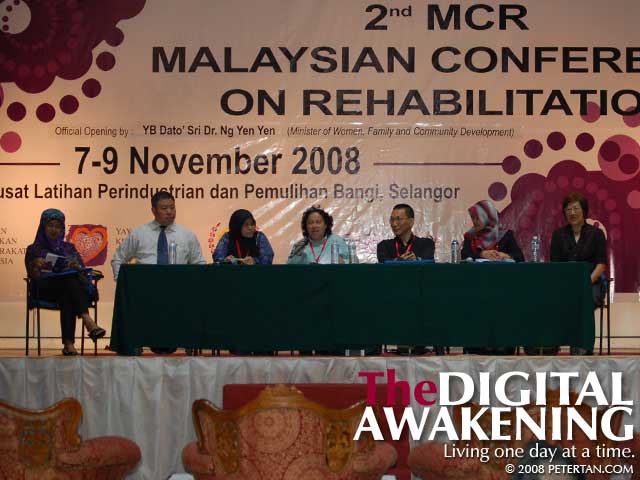
Panel Discussion 2 – Barrier-Free Built-Environment and Universal Design
(L-R) Puan Khairiah Talha, Mr Patrick Ang, Cik Khairul Nisa bt. Haron, Cik Naziaty Yaacob (Chairperson), Peter Tan, Puan Ch’ng Gaik Bee @ Dalilah Bee Abdullah and Puan Tan Choo Lan.
Photo by Wuan.
My first presentation at the panel session for special interest groups of the 2nd Malaysian Conference on Rehabilitation at Pusat Latihan Perindustrian and Pemulihan Bangi (PLPP) was titled “Inclusive Environment in Malaysia: From the Perspective of a Wheelchair User.” The main point of the entire presentation is the “Circle of Mobility for Disabled People.”

Circle of Mobility for Disabled People
The concept is very simple. The circle represents the journey from the point of origin to the destination and then from the final destination back to home. The journey includes the built environment which is represented by the line and public transport. The entire journey must be seamless. Any break in between may cause the disabled person to be stranded and unable to complete the journey.

Peter Tan speaking at the 2nd Malaysian Conference on Rehabilitation.
Photo by Wuan.
In Malaysia, the circle is broken in many places. The moment a disabled person gets out from the house, he will be faced with barriers in the built environment. These includes walkways without ramps, walkways littered with street furniture and other obstructions. Public transport is totally inaccessible. That is the reason why many wheelchair users are stuck at home and unable to go out.
The solutions are very simple actually. The government, be they federal, state or local, have the resources and means to resolve this issue. They must also take the blame for allowing this problem to fester until now. The four points for the solution that I presented were:
- Adopt Universal Design in all future infrastructural developments
- Enforce UBBL 34A and incorporate MS1331 into relevant legislation
Audit Access officers in local governments to implement and enforce UBBL 34A- Establish a time-frame to make Malaysia accessible to all
This is the abstract for my presentation:
Abstract
Inclusive Environment In Malaysia:
From The Perspective Of A Wheelchair User
Two important factors determine whether a disabled person becomes home-bound or live a full life outside. One is public transport, the other the built environment. One cannot exist without the other. Neither exists in Malaysia. Some may argue that parts of the built environment have become accessible in recent years. This is true to a certain extent. However, the lack of interconnectivity makes these pockets of accessible heaven another unreachable speck in the horizon for many still. There is an urgent need to impress upon the people responsible for infrastructure that an accessible environment not only provides mobility. It empowers disabled people to become independent and improves their productivity overall. Furthermore, an inclusive environment benefits everyone. What is good for disabled people is good for everyone else. This is a win-win situation for all. This paper presents my experience as a wheelchair user with examples gleaned from the Independent Living movement in Japan.
Below were the topics that my fellow panelists presented:
The Construction Industry’s Role in Facilitating for Social Inclusion
Puan Tan Choo Lan
Bahagian Kawalan Bangunan, Jabatan Kerajaan Tempatan,
Ministry of Housing and Local Government, Malaysia
Barrier-Free City Kuala Lumpur
Puan Ch’ng Gaik Bee @ Dalilah Bee Abdullah
Architect, Architect’s Department,
Kuala Lumpur City Hall
Barrier Free City Petaling Jaya
Cik Khairul Nisa bt. Haron
Assistant Director/Planner, Development Planning Department,
Petaling Jaya City Council, Selangor
Collaborating with the Local Authority in Achieving Barrier-free City, Singapore
Mr. Patrick Ang
Level Field Consultants
Singapore
Do We Need Legislative Changes Before We Care?
Puan Khairiah Talha
Secretary General, Eastern Regional Organization for Planning and Human Settlements (EAROPH)









